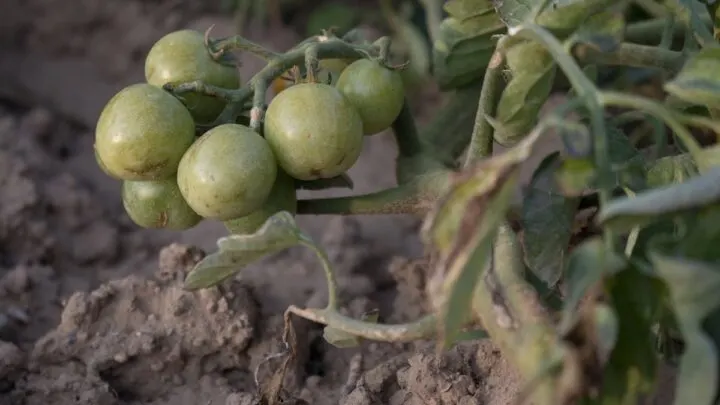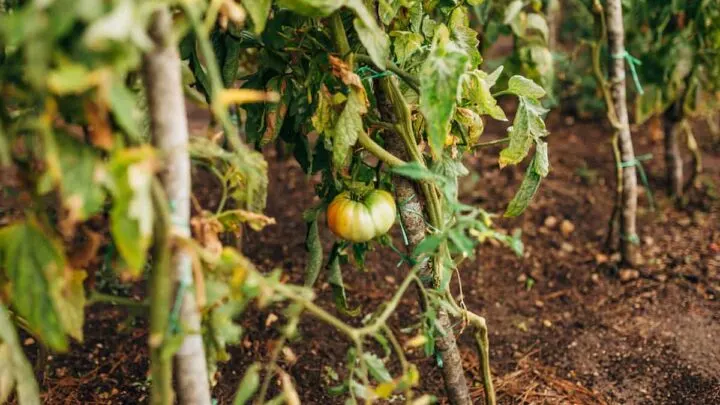Tomato plants are some of the most popular first vegetables for gardeners. They’re also a garden staple you’re likely to keep growing the whole time you have a garden because they’re some of the most versatile and beloved vegetables you can eat.
But, there are some challenges to getting tomatoes to grow correctly. One of the common mistakes gardeners make is planting tomato seedlings too close together.
Tomatoes need a lot of space, especially once the plants mature and are ready to start producing fruits. But it’s common for gardeners to accidentally plant their tomatoes too close or to try and fudge things a little to fit more tomatoes into a small garden space.
The problem is that when tomato plants are too close, they don’t produce as much fruit and can be more vulnerable to pests and disease.
Let’s talk about what is too close for tomato plants, what you can do to help those planted too close on accident, and the best options for helping tomato plants that are too close thrive.

How Close Is Too Close For Tomato Plants?
The first thing you need to know is how close tomato plants should be planted and how it varies between varieties.
Generally, all tomato plants, including cherry and grape, should be planted at least 12 inches apart.
Larger varieties of tomato plants, and some heirlooms, need more space than that. The range is usually up to 24 inches between plants, but some plants may need even more room if they are a large heirloom variety or if you have nutrient-poor soil.
How Can You Tell When Your Tomatoes Are Too Close?
Unfortunately, figuring out when your mature tomato plants are too close is often a trial and error, and your familiarity with the tomato variety and your area.
We recommend adding 1-2 inches of space for every additional inch in fruit size. Cherry and grape tomatoes might be fine 12 inches apart, but Roma tomatoes usually need 14-16 inches, and slicing tomatoes generally need 18 or more inches of dedicated space between tomatoes.
You may also need to plant slightly further apart if you plan to plant a vegetable, fruit, or herb between tomatoes. Tomato plants can thrive with nearby plantings of basil, asparagus, and other vegetables, but they still need plenty of space for airflow.
The most common sign that your tomatoes are too close is poor or stunted growth, not hitting growth milestones throughout the season, or producing leaves that are too pale or droopy.
Those signs take a little experience to spot, but once you know what you’re looking for, they become obvious.

When Should You Separate Tomato Plants
Ideally, you should never be in a situation where you must separate mature tomato plants because that almost always means disturbing their roots and risking severe damage.
It’s also physically difficult to move mature tomatoes because of their long and delicate stems.
Here’s what you can do to avoid having to separate tomatoes and how you can move them if you need to.
When To Separate Tomato Seedlings
If you’re starting your own seedlings, giving each tomato seed and the resulting seedling its own small container is a good idea.
That way, you don’t have to separate them; you’ll gradually increase the container size as they grow and need more root space.
A cardboard egg carton can make a great seedling starter if you poke holes in the bottoms of each spot. Cut the egg crate apart when it’s time to repot, remove the bottom of the cardboard, and plant it in the new container.
If you have more than one seedling in the same container, wait to thin them until at least one of the seedlings in each container has mature leaves growing in. Then remove the additional seedlings.
Most likely, the seedlings won’t be viable to replant at that phase – but you can try by giving them some loose, damp growing medium for a few days before planting them into a fresh seedling container.

Can You Move Mature Tomato Plants?
Moving mature tomato plants already in the ground is trickier, but it can be done.
You’ll need a good shovel, a prepared planting spot roughly 1 ft deep, and some fresh soil to fill in the hole from the tomato.
Start by cutting the ground around the tomato with the shovel. You want to be as far away from the tomato plant as possible without overcrowding the other tomato plant. Equidistant is best, whether that gives you a 6-inch or 10-12 inch radius.
You want to lift the tomato out of the ground rather than digging as much as possible. Lever the shovel under the plant as deep as possible and lift slightly. Then repeat all around the tomato plant until it lifts easily out of the ground.
Grasping the tomato by the soil and the base of the stem, lift it free. If your tomato plant is more than a foot tall, you may need someone else to help lift and keep the supporting tomato cage in place while you move the tomato.
What Can You Do If Mature Tomatoes Are Too Close Together?
If you have planted your tomato plant too close together, there are a few other options. These techniques can help you keep the plants healthy and still get a good harvest, but you’ll still likely have less productive tomatoes than if they had a little more space.

Give Your Tomato Plants Extra Water And Fertilizer
One way to help plants succeed even though they’re planted too close together is to give them more resources.
Lack of nutrients and water can make tomatoes more vulnerable to disease and pests, which are the biggest problems with planting them too close together.
Worse, tomatoes won’t fruit if they don’t have the nutrients they need to thrive. Planting tomatoes too close together can mean that neither plant will produce as many tomatoes as they would if they were planted further apart.
So, one way to counteract the problem is to provide both plants with extra water and fertilizer.
Don’t use more fertilizer than recommended per plant. That can risk root burn. Instead, fertilize the recommended amount slightly more often than recommended for tomato plants.
If you’re using a strong fertilizer, consider fertilizing normally the first round of fertilizer, followed by a half dose of fertilizer halfway to the next recommended fertilizing, and then a normal dose again at the recommended time. This provides more food but helps minimize the risk of damage.
Always provide extra water when fertilizing tomato plants to ensure the fertilizer gets into the soil and is distributed evenly.
Monitor Closely For Disease And Pests
When planted too close together, tomato plants become an even better target for pests and certain diseases.
While there aren’t any specific diseases more likely when tomatoes are planted close together, the risk of any disease increases slightly. It increases even more if the plants don’t have enough water and nutrients.
Keep a close eye on your tomato plants, and try to treat pests and diseases more aggressively when you find them.
Make Sure The Plants Get Good Airflow
Airflow might seem silly for your plants, but tomato plants are more likely to get diseases and pests if they aren’t allowed to dry completely between storms and waterings.
Good airflow is critical for this, so garden placement is essential. You may want to supplement the plants’ airflow if you’re having a particularly wet and humid summer.
That might mean pointing a fan at your tomato plants on sunny days between storms. We’ve seen it, we’ve done it, and it’s one of the best ways to protect tomatoes if they’re getting and staying too damp.
Just don’t leave a fan on longer than your tomatoes need because you’ll risk drying their leaves out too much, which is an entirely different problem.

Hi there, my name is Allie and welcome to my blog; GareningWithAllie!
Much of what you see written here is just our personal experiences with gardening. Along with the content I write here, there is also a unique collection of gardening topics covered by some of our close friends. I hope you find everything you read here to be helpful, informative, and something that can make your gardening journey the most lovely experience ever! With that said, Happy Gardening!
